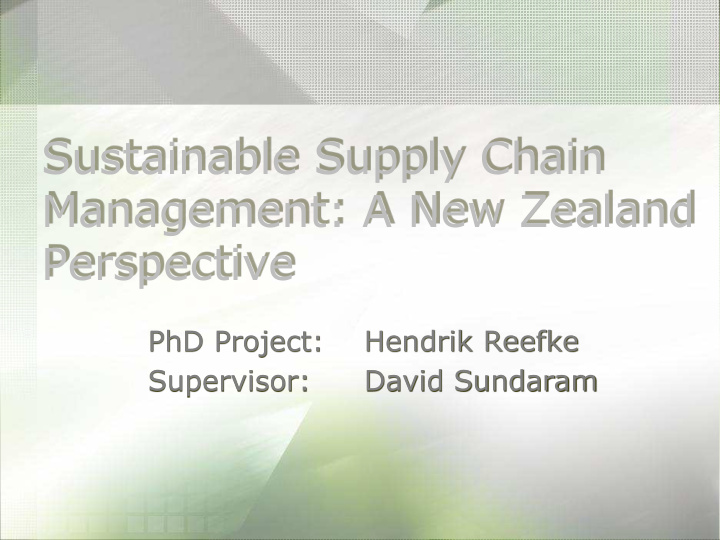



Sustainable Supply Chain Management: A New Zealand Perspective PhD Project: Hendrik Reefke Supervisor: David Sundaram
Agenda What is the research about? Why is it worth researching? Interaction with YOU! What will be done? What will be achieved?
Business Pressures Active Investors Ask for superior returns Employees Society Mobility Scarcity of talent Image can change quickly Customers Public opinion also Partners Less loyal Price transparency Greater choice Your Company New competitors Mergers and Acquisitions Source: SAP AG
What is Sustainability? Economic + Economic + Economic Social Environmental Performance Environmental Social Problems? Costs? Sustain- ability Social Environmental Performance Performance Elkington, 1998, McIntyre, 2007, Kleindorfer, Singhal, & Van Wassenhove, 2005 , Jayaraman, Klassen, & Environmental + Social Linton, 2007, Lye, Lee, & Khoo, 2001, Zhu & Business Survival? Sarkis, 2006
Practical Motivation “Why buy good X from far -away country Y when you could buy something similar that is produced locally and thus reduce your food miles?” (NZIER, 2009) “Given the potential economic impact of changes in buyers’ behaviour due to sustainability concerns, New Zealand exporters will need to continue to invest in demonstrating the sustainability of their products.” (The National Business Review, 2009) “Nearly 55% of New Zealand’s merchandise exports are related to food and beverages.” (Statistics New Zealand, 2008) “Wal -Mart, the world's largest retailer, plans to demand that all its suppliers measure the environmental cost of their products so Wal-Mart can calculate and post an eco- rating for each item” (NZ Herald, July 22, 2009)
Research Motivation Example: Fresh NZ Fish Export to US Fisheries Consumer Air Transport E E S n Road c o v Distributor o c i Transport n i r o a o m l n i m c e a n l t a l Skilling, 2007 , The New Zealand Institute, 2007
Research Areas Sustainability in SCM SCM for SCM for Sustainable Sustainable Operations Products Product Life Sustainable Sustainable Transportation & Waste Cycle Reverse Logistics Product Design Manufacturing Distribution Management Assessment Design for Re- Product Production Reduction Strategic Tactical Disassembly Manufacturing Recovery Operational Reverse Design for Waste Integration of Supply Network Inspection and Usage Prevention Networks Minimisation Product Design Planning Handling Planning Design for Production Forward Disposal Recycling Networks Recycling Planning Scheduling Design for Waste Reduction Disposal Regulations & Recycling Execution Inventory Health Hazards Management Human Rights & Work Conditions (Seuring & Müller, 2008; Seuring, 2007; Srivastava, 2000; Carter and Rogers, 2008)
Research Areas Supply Chain Management Monitor Strategic Network Design Demand Supply Network Planning Tactical Planning Transportation Production Distribution Operational Planning Planning Purchasing Planning & & & Vehicle Detailed Scheduling Deployment Scheduling Scheduling STORE BUY MAKE SELL MOVE (SAP AG – Supply Chain Management)
Research Problems Coordination of three dimensions How to measure performance levels Difficulty to identify boundaries Timeframe of observations Quantitative measures Economic focus Qualitative measures Method of measurement Different sectors / industries Different countries / cultures
CSCM Involvement What are sustainable SCs? What are the barriers? What are the enablers? What should be measured? How are these measures interrelated? Roadmap towards sustainable SCs
Delphi Study • Identify issues/aspects for SSCM in NZ: • Pressures & Incentives Round 1 • Impact on/of SSCM • Evaluation: • Ranking Round 2 • Comparison • Refinement • Contrasting Explanations Round 3 • Further Interviews
Expected Artefacts 1. Dimensions Define each dimension in the SSC context 2. Models Build theoretical models of interaction 3. Measures Construct KPIs which measure performance levels 4. Instruments Build framework which can be used as a practical instrument 5. Prescription Develop applicable strategies which enable companies to evaluate and re-design their processes
P • Dimensions: • Tiers: R • Economic, Social • Raw Material Environmental • Components and Parts O • Levels: • Assembly and Final Production • Ecological • Consumers C • Individual • Intermediate Customers E • Organizational • End-Customer • Political-Economic S • Social-Cultural Sustainability Supply Chain S Dimensions E Members & Levels S SSCM INPUTS OUTPUTS Strategy Supply Chain F Stakeholders E Management • Distribution Network • Rule-Makers and Configuration E • Inventory Control Watchdogs • Idea Generators and • Supply Contracts D Opinion Leaders • Distribution Strategies B • Business Partners and • Strategic Partnerships Competitors • Outsourcing and Procurement A • Consumers and • Product Design Community • Information Technology C • Investors and Risk • Customer Value Assessors K
Questions
Recommend
More recommend